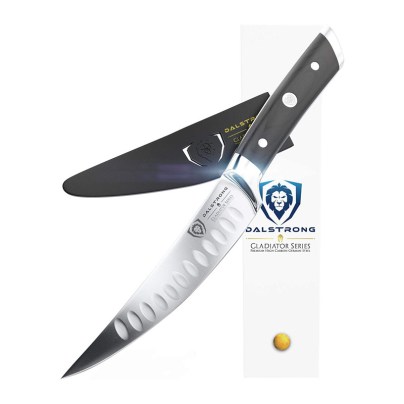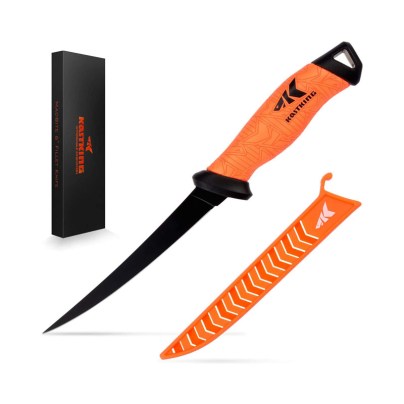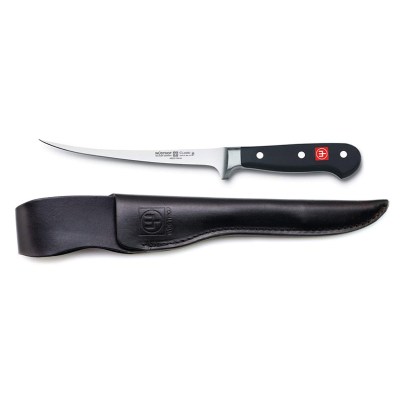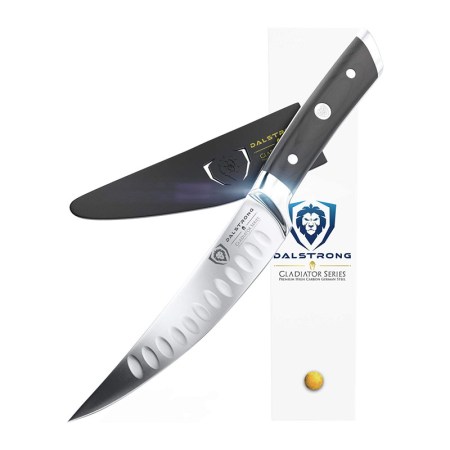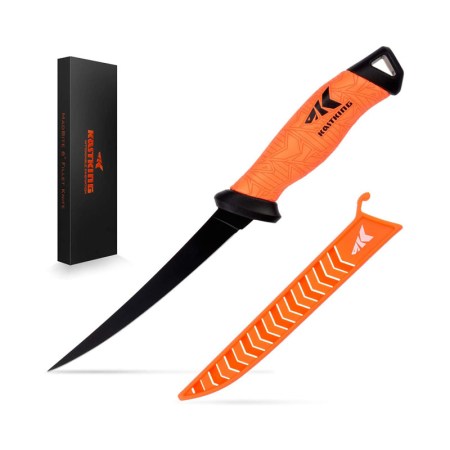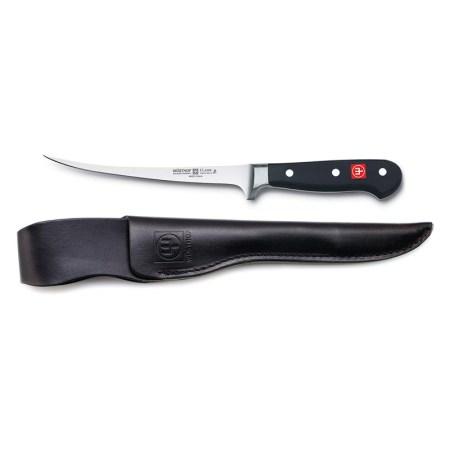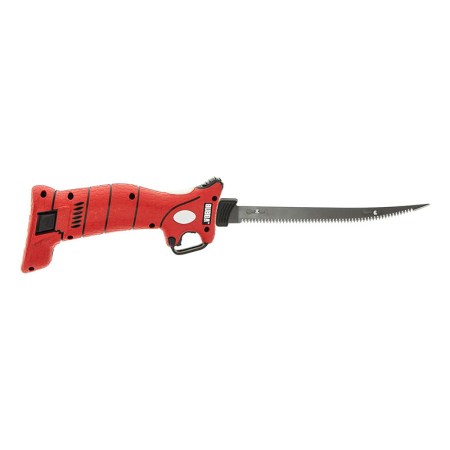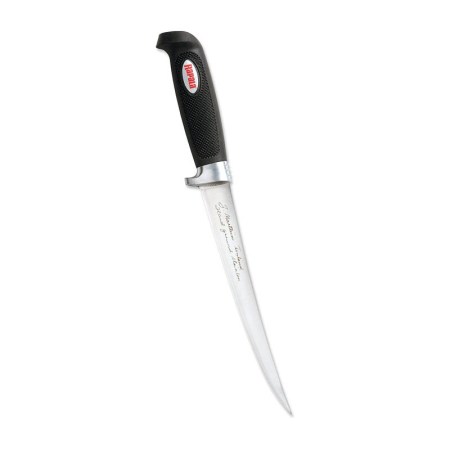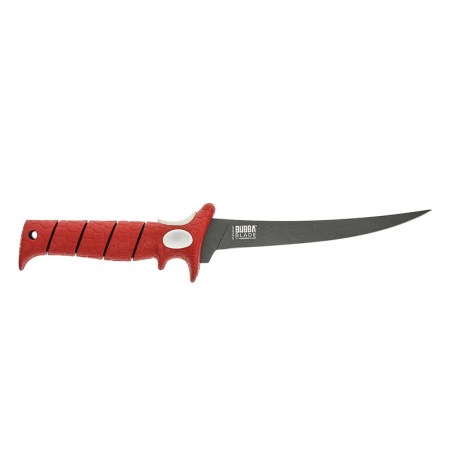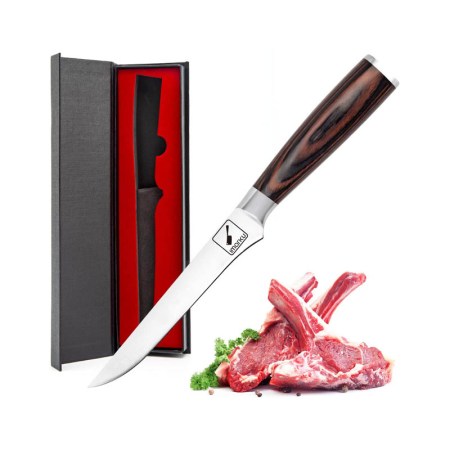We may earn revenue from the products available on this page and participate in affiliate programs. Learn More ›
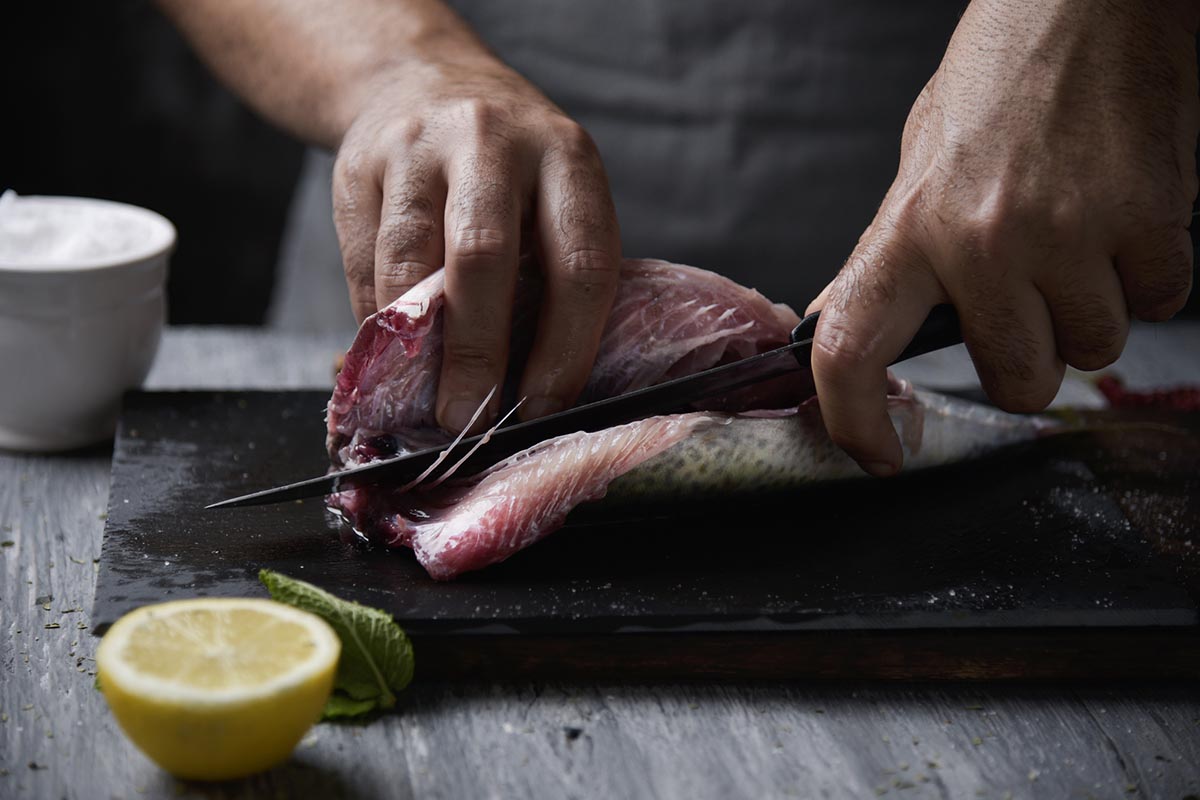
Filleting meat is a delicate task that requires just the right blade. Standard chef knives are too thick to cut cleanly along the bone, while paring knives don’t have long enough blades to handle larger cuts of meat. A designated fillet knife offers the length of a chef’s knife with the precision of a paring knife. Featuring an exceptionally sharp, thin blade, fillet knives are able to slice effortlessly through meat and make precise cuts along the bone to minimize waste.
The best fillet knives are made with high-carbon Japanese or German steel and durable construction that features full tangs running the length of the knife. In addition to quality material, a good fillet knife will have a large bolster that provides stability while protecting the user’s hand from cuts.
When shopping for the best fillet knife to add to your cutlery collection, there are several factors to consider. Read on to find out what to keep in mind when exploring your options as well as which models are among the best for filleting meat.
- BEST OVERALL: DALSTRONG Gladiator Series Fillet & Boning Knife
- BEST BANG FOR THE BUCK: KastKing Fillet Knife 6 Inch, Professional Level
- BEST UPGRADE: WÜSTHOF Classic 7 Inch Fillet Knife
- BEST ELECTRIC: Bubba Li-Ion Cordless Electric Fillet Knife
- BEST 9-INCH: Rapala4 Soft Grip Fillet / Single Stage Sharpener
- BEST FLEXIBLE: Bubba 7 Inch Tapered Flex Fillet Knife
- MOST VERSATILE: imarku Boning Knife, 6-Inch Fillet Knife

What to Consider When Choosing the Best Fillet Knife
Blade material, style of construction, and handle size are just a few of the critical features to take into account when shopping for the best fillet knife. Read on to learn more about what else to consider while shopping for the right fillet knife for your knife block.
Japanese vs. German
German and Japanese knives differ in edge, sharpness, hardness, and thickness. Keep in mind that the lower the angle in degrees, the sharper the knife. German knives have a wide blade angle in the neighborhood of 18 degrees, while Japanese knives tend to have blade angles of 10 to 15 degrees. This translates into better precision cutting from Japanese knives and better durability from German blades.
In terms of design, German blades typically have thick bolsters just before the handle, giving the knife the weight and strength for cutting through tougher vegetables and meats. Japanese knives usually don’t have bolsters, making them lighter.
Although both Japanese and German knives use steel, the alloy for each is a little different. Japanese steel has more carbon in it, making it harder than the steel used in German knives, which doesn’t have as much carbon. While more hardened blades will hold sharper edges, they’re also more prone to chipping and breaking. They also require more frequent sharpening to maintain their edge.
Japanese and German blades also differ in terms of tang, which is the metal part of the blade that extends through the handle. Some Japanese blades have a partial tang, which offers better maneuverability, while German blades generally have a full tang, which is stronger.
Manual vs. Electric
Fillet knives come in manual and electric versions. Manual filleting knives allow for precision cutting, relying on the user’s aim and arm strength to do the work. They feature a narrow blade that is often curved to facilitate the precision cutting filleting requires. The edge is smooth, allowing it to slice cleanly through the meat. For most people, a manual fillet knife is sufficient to handle their needs.
Electric filleting knives use two serrated blades that fit flush against each other and attach at the tip. The butt ends insert into a motorized handle with a mechanism that causes the blades to oscillate back and forth in opposite directions, sliding against each other to create a sawing action. Electric filleting knives cut very quickly through meat but are harder to control. These knives are best for chefs, butchers, or fishers who need to fillet a large volume of meat.
Blade Flexibility and Size
Fillet knives have long, thin, sharp blades that are flexible for easier cutting around bone structures without the blade getting caught up in the flesh. With this in mind, know that most fillet knives are notably narrower than a chef’s knife to allow for this flexibility while reducing friction. They also max out in the mid-50s on the Rockwell scale, which measures blade hardness, to maintain that flexibility.
Fillet blades vary in length, with most measuring between 6 inches and 9 inches. The longer the blade, the bigger the cut of meat the knife can manage. A 6-inch blade is suitable for filleting small fish, such as trout, while a longer blade is suitable for filleting larger cuts of meat or bigger fish, such as salmon.
Blade Features and Material
In addition to a long, flexible blade with a sharp edge, the blades on the best fillet knives will have other features in order to make filleting meat easier. A pointed end allows the tip to puncture through flesh, while a narrow blade maneuvers more easily around bone and through sinew without snagging. Some blades include a series of small pockets along the side, which reduces friction as the knife cuts through thicker cuts of meat and prevents the blade from getting caught. Many fillet knives also have curved blades, which maximize the size of the knife edge and allow for more precise cuts.
In general, fillet knife blades are made of either carbon steel (sometimes referred to as high- carbon steel) or stainless steel. Carbon steel blades are harder than stainless steel. These durable blades hold their shape while cutting, resist abrasions, and carry a sharper edge. They also require more maintenance and care.
Stainless steel blades don’t perform as well as carbon steel blades; however, they resist rust and hold their edge better when cutting through meat or into a cutting board, making them suitable for the casual chef.
Full vs. Partial Tang
The tang is the metal part of the blade that includes the blade and the piece that extends through the handle. A full tang knife has metal that extends from the tip of the blade to the butt of the handle. With a partial tang blade, the tang is inserted into the handle but does not run the full length. Full tang knives are stronger with no weak point for leverage from tip to butt. Since the metal runs the knife’s length, full tang knives also have better balance. High-end knives will feature a full tang. Although full tang blades are generally superior, a good partial tang knife will be lighter with a front-loaded weight that makes it easier to make precision cuts.
Handle Features
Filleting requires cutting in and around bone while applying a considerable amount of pressure. Inconsistencies in meat, bone, and sinew can cause unexpected starts and catches while cutting. Often while cutting, hands become wet or even greasy from the fish or meat’s juices. All of this amounts to an increased risk of cuts.
With that in mind, the best fillet knives have features that minimize this risk. Some fillet knives, especially those meant for use in the field, have a rubberized handle that provides a more reliable grip for both dry and wet hands. These handles work especially well for filleting large quantities of meat, where speed is a factor.
A good fillet knife should also have a handle that features a hilt at the base to prevent the hand from slipping forward onto the blade. The handle should be broad enough for the entire hand to fit comfortably between the hilt and the butt.
Fillet knives meant for kitchen use typically have hard plastic or wooden handles. While these handles don’t offer the same grip as knives with rubber handles, their aesthetics better fit a kitchen environment.
Color
Most fillet knives are the standard steel gray most people are accustomed to, but fillet knives used in industrial or outdoor settings are typically black. The black finish prevents rust from forming on the blade while creating a nonstick surface that slides more easily through flesh.
Our Top Picks
This list of the best fillet knives takes into account the above considerations in trimming the field to some of the top knives on the market. Any of the products below will do an excellent job of filleting fish, poultry, and other meats.
Best Overall
DALSTRONG Gladiator Series Fillet u0026 Boning Knife
See ItThis 6-inch German fillet knife is specifically designed for carving meat and sinew from the bone. A series of pillows along the edge of the blade coupled with a sharp 14- to 16-degree edge per side prevents the premium-quality high-carbon steel blade from getting hung up in meat by reducing friction, allowing it to slice smoothly through flesh.
Perhaps its most striking feature is the sweeping curve of its blade and handle, both of which provide excellent maneuverability for working the blade between skin and flesh and around bones and joints.
With a 55 hardness rating on the Rockwell scale, this knife is hard enough to hold a sharp edge without being so hard that it will crack under the pressure of filleting. A tip-to-butt full tang construction adds durability, and an ample bolster provides counterweight and protection from cuts and nicks.
Best Bang for the Buck
KastKing Fillet Knife 6 Inch, Professional Level
See ItHigh-end knives can be an expensive investment, but KastKing’s fillet knife offers a quality blade for filleting at an affordable price. Its stainless steel German blade features a black finish that resists rust while allowing for smooth slices through meat. Featuring a gradual curve with a thin, flexible edge, the 6-inch blade allows for easy maneuverability around bones.
A 5.8-inch slip-resistant handle with ergonomic curves allows for a firm grip, even with wet hands, and a curved hilt protects hands from sliding onto the blade. An included protective sheath keeps the edge covered and prevents accidental cuts when the knife is not in use, and open slots in the sheath let the blade dry while stored.
Best Upgrade
WÜSTHOF Classic 7 Inch Fillet Knife
See ItThis fillet knife from one of the best-known names in cutlery may be an investment, but the quality it offers makes it worth the high price tag. With a 58 rating on the Rockwell scale, this blade is harder than most knives, in addition to being sharper and better able to retain its edge. A thin profile with a blade that tapers upward from hilt to point allows it to slide easily through flesh while offering excellent maneuverability for cutting along the bone.
A full tang runs the entire length of the knife, giving it plenty of strength for applying the pressure needed for filleting meat from the bone. The curved handle with a full bolster and large butt prevents the user’s hand from slipping forward or backward while cutting.
Best Electric
Bubba Li-Ion Cordless Electric Fillet Knife
See ItFor fishers who reel in many fish and need quicker means for filleting them than what a manual knife can offer, this battery-powered option from Bubba is a worthy solution. This fillet knife features a dual-rivet blade powered by two lithium-ion batteries that cut rapidly through meat and sinew, making quick work of a filleting job. An ergonomically shaped handle with a rubber grip ensures a firm grip on this knife when cutting along the bone, while a trigger guard adds safety by keeping fingers safely away from the moving blade.
This versatile tool comes with four blades: a flexible 7-inch blade, a stiff 9-inch blade, a flexible 9-inch blade, and a stiff 12-inch blade. The flexible blades are narrower and allow for maximum maneuverability around bones, while the wider, rigid blades add strength for cutting through tough parts. A convenient LED battery life indicator lets the user know when the battery is running low, and a carrying case keeps the drive and blades organized for transport.
Best 9-Inch
Rapala4 Soft Grip Fillet / Single Stage Sharpener
See ItWhen handling a cut of meat or fresh catch that’s on the larger side, it’s helpful to have a filleting knife on hand with a longer blade. In addition to its 9-inch length, this knife’s long, flexible stainless steel blade features a thin profile and curved shape, making it ideal for filleting large cuts of meat or fish, including salmon.
A soft grip with a molded texture makes for an ergonomic handle, while a large hilt keeps fingers from sliding forward. The butt tapers outward, preventing the knife from slipping out of the user’s hand. In addition to a black sheath that protects the blade and prevents cuts when the knife is not in use, this knife also includes a one-stage sharpener that helps the user maintain the blade’s edge for top performance.
Best Flexible
Bubba 7 Inch Tapered Flex Fillet Knife
See ItIf precision is a priority, consider this 7-inch fillet knife from Bubba. Its ultrathin tapered blade offers significant flex, which allows for easy use and maneuverability. Coupled with the blade’s rust-resistant coating, this knife is especially ideal for filleting fish on the go.
This knife also features other design innovations, including an extra-sharp tip on the blade that makes starting cuts easier. An ample handle with a nonslip grip features extra padding around pressure points to help prevent chafing and blisters while also helping prevent the user’s hand from slipping off the handle and keeping bones and spines away from the user’s hand. An included sheath keeps the blade protected when not in use.
Most Versatile
imarku Boning Knife, 6-Inch Fillet Knife
See ItWith a shorter length and wider blade than most fillet knives, this model from imarku can handle a variety of cutting duties, including filleting, boning, and other basic butchering tasks. The blade is made of high-carbon German steel with a Rockwell rating of 56, giving it excellent hardness while remaining soft enough to resist chips. A 14- to 16-degree edge provides a good balance of sharpness while allowing the blade to retain its edge longer.
In addition to preventing accidents, the nonslip Pakkawood handle is attractive enough to display in a knife block. A large bolster serves as an effective guard while cutting as well as providing a stop that prevents the user’s hand from sliding forward onto the blade.
FAQs About Fillet Knives
Still have some questions about how to choose the best fillet knife? Take a look at some of the most commonly asked questions about this type of cutlery.
Q. What is the difference between a boning knife and a fillet knife?
Boning knives are designed specifically for removing bones from meat, while fillet knives are designed to move along the contours of bones to remove flesh from smaller pieces of meat. The two are very similar, with some knives capable of performing both tasks.
Q. What size fillet knife do I need?
It depends on what you’re filleting. A 7-inch blade is suitable for filleting small fish, such as trout and bass, while a 9-inch blade is a better choice for filleting large fish, such as salmon.
Q. How do you use a fillet knife on fish?
After gutting, cleaning, and beheading the fish, run the fillet knife down the fish’s spine from the tail to the head, using the backbone as a guide. Use a slicing motion versus a sawing motion to create a smooth, even cut.
Q. How do you use an electric fillet knife?
When using an electric fillet knife, keep the fish’s head intact. Starting just below the head, cut from head to tail using the spin as a guide. Keep one hand on the head to hold the fish steady while cutting.
Q. How often do you need to sharpen a fillet knife?
A carbon steel knife should be sharpened before each use, whereas you should sharpen a stainless steel knife every two to four uses.
